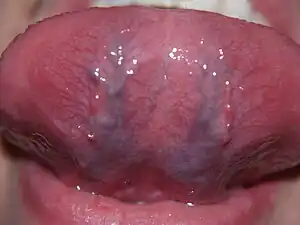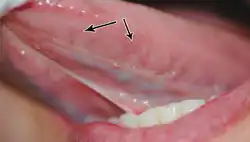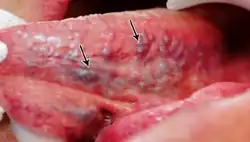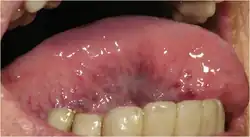Caviar tongue
| Caviar tongue | |
|---|---|
| Other names: Lingual varicosities, sublingual varices | |
 | |
| Normal appearance of the undersurface of the tongue, showing prominent veins | |
| Symptoms | Purplish nodular swelling of veins on undersurface of the tongue[1] |
| Complications | Phleboliths, thrombophlebitis[1] |
| Usual onset | Older age[1] |
| Causes | Ageing loss of skin elasticity[1] |
| Risk factors | Smoking[2] |
| Treatment | None[1] |
| Frequency | Common[1] |
Caviar tongue is a type of varicose vein that appears as purplish swellings on the undersurface of the tongue.[1][2]
The condition results from ageing loss of elasticity of the skin, and may be associated with Fordyce angiokeratomas.[1] It is generally observed in people over the age of 50-years.[1] There may be an association with smoking.[2] Cardiovascular or lung problems may be present.[3] The swellings tend to become more prominent with aspirin, anticoagulant medicines and hot food and drink.[2] Complications include phleboliths and thrombophlebitis.[1]
They are common.[1] It was first described by William Bennett Bean in 1952.[4]
Signs and symptoms
The appearance is of purplish nodular swelling of veins found on the undersurface of the tongue.[1] The swellings tend to become more prominent with aspirin, anticoagulant medicines and hot food and drink.[2]
 Caviar tongue grade 0
Caviar tongue grade 0 Caviar tongue grade 1
Caviar tongue grade 1 Caviar tongue grade 1
Caviar tongue grade 1
Cause and mechanism
It is normal for there to be veins visible underneath the tongue, partly because the mucous membrane is so thin and translucent in this region, but where these vessels become dilated and tortuous, they may appear round and black like caviar.[5] It results from ageing loss of elasticity of the skin, and may be associated with Fordyce angiokeratomas.[1] It is associated with people over the age of 50-years.[1] There may be an association with smoking.[2] Cardiovascular or lung problems may be present.[3] Complications include phleboliths and thrombophlebitis.[1]
References
- 1 2 3 4 5 6 7 8 9 10 11 12 13 14 15 James, William D.; Elston, Dirk; Treat, James R.; Rosenbach, Misha A.; Neuhaus, Isaac (2020). "34. Disorders of the mucous membranes". Andrews' Diseases of the Skin: Clinical Dermatology (13th ed.). Edinburgh: Elsevier. pp. 800–801. ISBN 978-0-323-54753-6. Archived from the original on 2023-06-30. Retrieved 2023-06-07.
- 1 2 3 4 5 6 Malamos, Dimitris; Scully, Crispian (2021). "25. Normal variations". Clinical Guide to Oral Diseases. Hoboken: John Wiley & Sons. pp. 333–338. ISBN 978-1-119-32813-1. Archived from the original on 2023-06-30. Retrieved 2023-06-07.
- 1 2 Rao, Jyotsna (2017). QRS for BDS IV Year, Vol 2. Elsevier. p. 1403. ISBN 978-81-312-4935-2. Archived from the original on 2022-05-10. Retrieved 2022-05-10.
- ↑ Mulliken, John B. (2013). "13. Capillary malformations, hyperkeratotic stains, telangiectasias, and miscellaneous vascular blots". In Mulliken, John B.; Burrows, Patricia E.; Fishman, Steven J. (eds.). Mulliken and Young's Vascular Anomalies: Hemangiomas and Malformations (2nd ed.). Oxford University Press. p. 552. ISBN 978-0-19-972254-9. Archived from the original on 2023-06-30. Retrieved 2023-05-19.
- ↑ Viswanath, V; Nair, S; Chavan, N; Torsekar, R (Jan–Feb 2011). "Caviar tongue". Indian Journal of Dermatology, Venereology and Leprology. 77 (1): 78–9. doi:10.4103/0378-6323.75002. PMID 21220892.